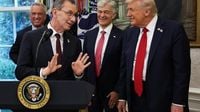On September 30, 2025, President Donald Trump stood alongside Pfizer CEO Albert Bourla in the Oval Office to unveil a sweeping new initiative aimed at lowering prescription drug costs in the United States—a move that has sent shockwaves through the pharmaceutical industry and sparked debate among patients, experts, and policymakers alike. At the heart of this effort is the upcoming launch of TrumpRx, a federal government-operated website set to go live in early 2026, which promises Americans access to discounted medicines directly from manufacturers.
"The United States is done subsidizing the health care of the rest of the world," Trump declared at the news conference, according to CNN. "By taking this bold step, we’re ending the era of global price gouging at the expense of American families." The new TrumpRx platform, he said, would allow consumers to search for their medications and be redirected to manufacturers’ direct-to-consumer channels, bypassing traditional insurance and pharmacy benefit managers (PBMs).
The star of the announcement was a landmark deal with Pfizer, the first major drugmaker to acquiesce to the president’s demands after months of tense negotiations and public pressure. Under the agreement, Pfizer will sell many of its primary care medicines and certain specialty brand-name drugs at an average of 50% savings on TrumpRx. The company also pledged to offer its drugs to Medicaid at "Most Favored Nation" prices—the lowest available in peer countries such as Canada, the UK, and Germany—starting in early 2026.
For those paying cash without insurance, the TrumpRx website could unlock significant savings. But, as NPR notes, the discounts are calculated off a drug’s list price, which is often much higher than what insured patients actually pay. "Specific terms of the agreement remain confidential," Pfizer said in its press release, leaving some experts to wonder just how meaningful the savings will be for most Americans. As Ameet Sarpatwari, a pharmaceutical policy expert at Harvard Medical School, told NPR, "I think it’s more underwhelming than what the president is touting. I think it’s more window dressing than the transformational sort of reforms that are needed to really provide relief to Americans struggling with high prices."
The deal also comes with a carrot-and-stick approach to domestic manufacturing. Pfizer has committed to investing an additional $70 billion in U.S.-based research and manufacturing projects over the coming years. In return, the company will enjoy a three-year reprieve from new tariffs on pharmaceutical imports—a crucial concession, given Trump’s threat to impose a 100% tariff on brand-name drug imports beginning October 1, 2025, for companies that do not build manufacturing plants in the U.S. Imports from the European Union, meanwhile, will face a 15% levy under a recent trade agreement.
Pfizer’s decision to break ranks and strike a deal with the administration caught much of the pharmaceutical industry off guard. As Axios reported, the move has created "an uproar within much of the pharmaceutical industry, most of which was caught off guard by the announcement." Albert Bourla, who also serves as board chair of PhRMA—the industry’s top trade group—put other drugmakers in a tight spot after months of unified resistance to Trump’s "Most Favored Nation" pricing plan. PhRMA CEO Steve Ubl responded, "each company makes its own decision" on pricing, but warned that the deal "does not do enough to address the real drivers of higher prices in the U.S.," such as PBMs and hospital markups, and cautioned that most-favored-nation pricing would harm innovation.
President Trump, undeterred, signaled that he expects other companies to follow Pfizer’s lead, naming Eli Lilly as a likely next participant and raising the specter of additional tariffs for those who do not comply. According to Axios, pharmaceutical lobbyists described the agreement as "more far-reaching than they expected" and predicted it would ramp up pressure on other companies to reach similar terms on international pricing parity and other issues.
Under the terms of the deal, Pfizer agreed not to launch new drugs in the U.S. at prices higher than in other wealthy countries, though there is no cap on the launch price overall. While this sounds promising, analysts caution that the agreement is not focused on existing drugs for Medicare or commercial insurance patients. Medicaid, which already pays very low prices for prescription drugs, represents less than 5% of Pfizer’s U.S. sales, making the impact of "Most Favored Nation" pricing within Medicaid "immaterial" for the company, according to a Leerink Partners analyst note cited by Axios.
The TrumpRx site itself will not sell or distribute medications directly. Instead, it will serve as a gateway, redirecting consumers to pharmaceutical companies’ direct-purchase programs. This model echoes recent moves by other manufacturers: Novo Nordisk, for example, now offers Ozempic—a blockbuster diabetes drug—at $499 per month for cash-paying patients, compared to a list price of nearly $1,000.
Still, the practical impact for most Americans remains uncertain. As Stacie Dusetzina, a health policy professor at Vanderbilt University Medical Center, told CNN, "Most of the medicines the White House touted don’t appear to be used very often in the U.S." She singled out Xeljanz, a rheumatoid arthritis drug, as an exception, but noted that its list price exceeds $6,000 a month. Even with a 40% TrumpRx discount, patients would still pay around $3,600 monthly—hardly a bargain for most families. "How is this a reasonable cash price?" Dusetzina asked. "It really isn’t."
Industry experts have also raised broader concerns. Chris Meekins, a health policy analyst at Raymond James, wrote that the TrumpRx website "is likely irrelevant as few will pay out of pocket unless there are changes in insurance policies." Many believe the real drivers of high drug costs—insurers, PBMs, and opaque supply chains—are left untouched by the current initiative.
Meanwhile, the pharmaceutical industry has warned that "importing foreign price controls would undermine American leadership, hurting patients and workers," as PhRMA’s Alex Schriver said in July. Some analysts worry the deal could even backfire, with drugmakers potentially raising prices in other countries or delaying product launches abroad to offset revenue losses in the U.S. In fact, Eli Lilly recently hiked the price of its weight-loss drug Mounjaro in the UK, and Bristol Myers Squibb matched U.S. prices for its schizophrenia medication Cobenfy in the UK.
Despite these warnings, the markets responded favorably—Pfizer’s stock jumped 6.8% on the day of the announcement, and shares of other large drugmakers also rose. For now, the Trump administration appears committed to pursuing voluntary deals rather than imposing regulations, which would likely face legal challenges.
As the dust settles, one thing is clear: Trump’s bold new direction on drug pricing has upended the status quo, forcing drugmakers, insurers, and policymakers to grapple with a rapidly shifting landscape. Whether these moves will lead to meaningful relief for American patients or simply reshuffle the deck remains to be seen, but the debate over drug prices in the U.S. is far from over.





